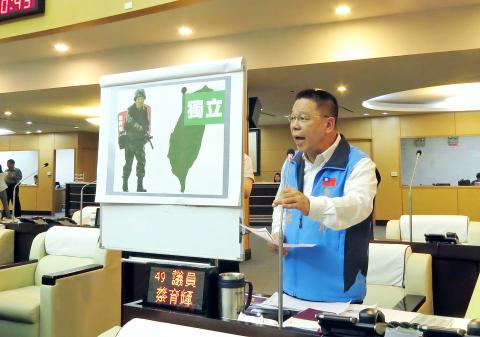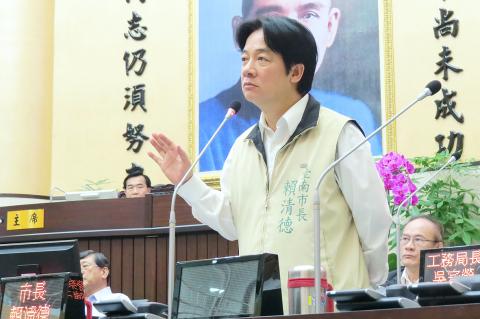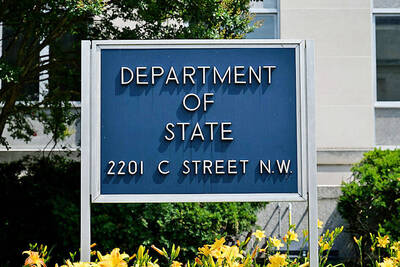The Chinese Nationalist Party (KMT) legislative caucus yesterday accused Democratic Progressive Party (DPP) presidential candidate Tsai Ing-wen (蔡英文) of playing a two-handed strategy to deceive voters into supporting her by pledging to maintain the cross-strait “status quo,” while letting Tainan Mayor William Lai (賴清德) advocate Taiwanese independence.
“Lai [of the DPP] said on Wednesday that he supports independence, but not the use of force. Given that his stance is contradictory to that of his chairperson, the caucus demands that Tsai gives the public a clear explanation on the matter,” KMT deputy caucus whip Lin Te-fu (林德福) told a morning press conference in Taipei.
Accusing Tsai and Lai of collaborating to cheat voters, Lin said that the KMT’s definition of the “status quo” is based on the “three noes” policy of “no independence, no unification and no use of force,” as well as the so-called “1992 consensus,” referring to a tacit understanding between the KMT and the Chinese government that both sides of the Taiwan Strait acknowledge there is “one China,” with each side having their own interpretation of what “one China” is.

Photo: Tsai Wen-chu, Taipei Times
Refusal to accept the “1992 consensus” alone could enrage the leadership in China, Lin said.
“The KMT really wants to see Taiwanese being able to live and work in peace on this island,” he said.
KMT caucus whip Lai Shyh-bao (賴士葆) said there is a deeper meaning behind Lai’s declaration of support for independence on Wednesday, as it was the eighth anniversary of the DPP’s passage of the “Normal Country Resolution.”

Photo: Tsai Wen-chu, Taipei Times
The resolution advocates renaming the country “Taiwan” and the enactment of a new constitution, Lai Shyh-bao said, adding that the mayor’s comments showed Tsai’s pledge to maintain the “status quo” was nothing but a ploy to gain votes.
“Having an influential politician like William Lai make such a politically sensitive statement on this particular date ... we suspect that they are playing a two-handed strategy,” Lai Shyh-bao said.
“We believe Tsai is responsible for attracting swing voters with her promise of maintaining the ‘status quo,’ while the mayor is in charge of reassuring ‘deep-green’ voters by reiterating the party’s pro-independence stance,” he said.
He added that the mayor might have made the statement in an attempt to shift public focus away from the escalating outbreak of dengue fever in the south.
Citing a July survey conducted by the Mainland Affairs Council (MAC), KMT Legislator Wu Yu-sheng (吳育昇) said that 72.2 percent of respondents supported maintaining the “status quo” based on the “three noes” policy.
“That means the mayor’s claim that independence has received the maximum consensus among Taiwanese is nonsense and an outright lie,” Wu said.
MAC Minister Andrew Hsia (夏立言) said that the government’s stance has always been clear: that the cross-strait status of “no independence, no unification and no use of force” be maintained based on the “1992 consensus,” the principle of “one China, with different interpretations” and the Constitution.
“Cross-strait relations have stabilized and prospered over the past seven years. We hope that everyone will cherish this stance,” Hsia said.
KMT presidential candidate Hung Hsiu-chu (洪秀柱) said William Lai has remained unwavering in his support of Taiwanese independence.
“On the contrary, Tsai has repeatedly shifted her stance on the issue, from the 1999 “special state-to-state” theory and reference to the Republic of China [ROC] government as “a government-in-exile,” to the DPP’s vows to safeguard the existence of the ROC,” Hung said.
"I do not know whether Tsai and the mayor have some sort of tacit agreement, or are they playing ‘good cop, bad cop,’” Hung added.
Asked whether his remarks could impact the tourism industry, William Lai said in Tainan that the country must seek to be self-reliant, as overdependence on others would always result in it being held over a barrel.
“The DPP’s ‘1999 Resolution on Taiwan’s Future’ states that Taiwan is an independent, sovereign state called the ROC [Republic of China] and that its future must be decided by its own people,” the mayor said.
Tsai said she has made her cross-strait policy platform clear.
“As a presidential candidate, I have made my cross-strait policy idea very clear during my speech at the Center for Strategic and International Studies in the US,” Tsai told reporters. “It is to push for peaceful and stable development of cross-strait relations in line with public opinion under the current constitutional framework of the ROC.”
She added that William Lai’s remarks should not be overinterpreted, as the mayor only seeks mutual understanding and peaceful coexistence across the Strait.
Asked if the mayor’s remarks would have any impact on the DPP, Tsai said that sometimes, it is just a “question of definition,” adding that the consensus in Taiwanese society is in line with her ideas.

A car bomb killed a senior Russian general in southern Moscow yesterday morning, the latest high-profile army figure to be blown up in a blast that came just hours after Russian and Ukrainian delegates held separate talks in Miami on a plan to end the war. Kyiv has not commented on the incident, but Russian investigators said they were probing whether the blast was “linked” to “Ukrainian special forces.” The attack was similar to other assassinations of generals and pro-war figures that have either been claimed, or are widely believed to have been orchestrated, by Ukraine. Russian Lieutenant General Fanil Sarvarov, 56, head

SAFETY FIRST: Double the number of police were deployed at the Taipei Marathon, while other cities released plans to bolster public event safety Authorities across Taiwan have stepped up security measures ahead of Christmas and New Year events, following a knife and smoke bomb attack in Taipei on Friday that left four people dead and 11 injured. In a bid to prevent potential copycat incidents, police deployments have been expanded for large gatherings, transport hubs, and other crowded public spaces, according to official statements from police and city authorities. Taipei Mayor Chiang Wan-an (蔣萬安) said the city has “comprehensively raised security readiness” in crowded areas, increased police deployments with armed officers, and intensified patrols during weekends and nighttime hours. For large-scale events, security checkpoints and explosives

PUBLIC SAFETY: The premier said that security would be tightened in transport hubs, while President Lai commended the public for their bravery The government is to deploy more police, including rapid response units, in crowded public areas to ensure a swift response to any threats, President William Lai (賴清德) said yesterday after a knife attack killed three people and injured 11 in Taipei the previous day. Lai made the remarks following a briefing by the National Police Agency on the progress of the investigation, saying that the attack underscored the importance of cooperation in public security between the central and local governments. The attack unfolded in the early evening on Friday around Taipei Main Station’s M7 exit and later near the Taipei MRT’s Zhongshan

REBUFFED: In response to Chinese criticism over recent arms sales, Washington urged Beijing to engage in meaningful dialogue instead of threats and intimidation Washington’s long-term commitment to Taiwan would not change, the US Department of State said yesterday, urging Beijing to stop pressuring Taiwan and engage in meaningful bilateral dialogues. The remarks came in response to a backlash from Beijing about Washington’s latest approval of arms sales to Taiwan. The US Defense Security Cooperation Agency said in a statement on Wednesday that the Taipei Economic and Cultural Representative Office in the US has asked to purchase an arms package, including Tactical Mission Network Software; AH-1W helicopter spare and repair parts; M109A7 self-propelled howitzers; HIMARS long range precision strike systems; tube-launched, optically tracked, wire-guided missiles; Javelin